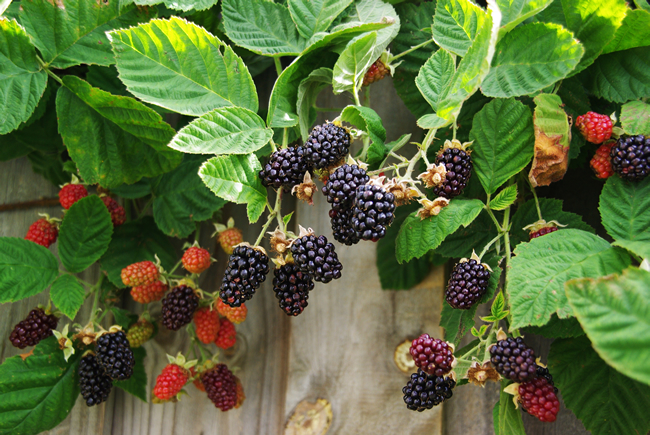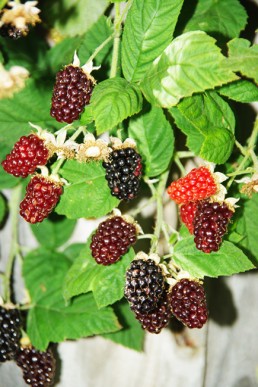Article and photos by Gail Thomas
 Marionberries are one of the most luscious summer fruits, and although the plants are thorny the resulting delicious fruit far outweighs any prickly encounters! A cross between the Chehalem and Olallieberry blackberries, this vigorous trailing cane blackberry cultivar is named after the county of Marion Oregon where they were developed in the 1950’s.
Marionberries are one of the most luscious summer fruits, and although the plants are thorny the resulting delicious fruit far outweighs any prickly encounters! A cross between the Chehalem and Olallieberry blackberries, this vigorous trailing cane blackberry cultivar is named after the county of Marion Oregon where they were developed in the 1950’s.
 Marionberries do well in areas with cooler winters, will benefit with an application of general fertiliser and potash in spring and are best trained along a wire trellis or fence line, ideally at eye level so they are easy to harvest. Ties or ‘S’ type hooks placed along a fence are good to support the canes during the growing season.
Marionberries do well in areas with cooler winters, will benefit with an application of general fertiliser and potash in spring and are best trained along a wire trellis or fence line, ideally at eye level so they are easy to harvest. Ties or ‘S’ type hooks placed along a fence are good to support the canes during the growing season.
A good hint is to tie a little green tag at the base of each cane to identify the current year’s growth – the first year train the canes along the fence or trellis as these will fruit the following year.
Flowers appear in October-November with fruit ripening from mid December to mid-late January. New canes establish during the growing season. In winter it is easy to identify those canes which have fruited and need to be pruned as these are the ones with the green tags. Cut these at ground level keeping 4-5 strong new canes for the next season. To make identification easy for the following year transfer the tags to the new growth and repeat the same procedure each year.
Net plants as the fruit ripens. If growing on a fence-line peg netting to the top of the fence and drape it down over the plants, that way you only have to net one side with the fence providing extra protection.
Harvest the fruit when it has ripened past the shiny black stage to a duller velvety black hue – even though the shelf life will be shorter these plump elongated perfumed berries will boast a rich and intense flavour with a clean finish. Marionberries can be enjoyed fresh, in a summer pudding or trifle, pureed for a sauce, as a perfect accompaniment to creamy blue cheeses or transformed into ice cream or a vibrant jam. They can also be frozen for later use.
